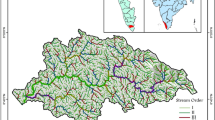Abstract
Research in the field of river hydrology has been mainly concerned with the investigation of the rainfall-runoff phenomenon through the analysis of hydrological factors such as meteorology and geography, with the focus being on each river basin. Recently, various forms of digital information such as GIS (Geographic Information System) and RS (Remote Sensing) data have been made available in worldwide digital map format. Therefore, there has been a shift in focus from lumped-parameter models to distributed runoff models, as the latter can consider temporal and spatial variations in water quantity. Distributed runoff models have made possible the comparison of runoff field and rainfall-runoff characteristics considering spatial distribution. Hydrological conditions are differently distributed regionally or nationally, and each river basin has unique characteristics. The main purpose of this study is to compare hydrological characteristics in several river basins and methodologies by using a GIS based distributed runoff model and AHP (Analytic Hierarchy Process) for the analysis of river basins based on their regional hydrological characteristics and considering their temporally and spatially-distributed physical properties is proposed. Based on the methods, the main purpose of this study, as proposed is to clearly identify the characteristics and similarities for each river basin so that we can understand the differences and similarities of river basin characteristics quantitatively and to provide objective criteria for the characteristics of each river basin as a basic study on comparative hydrology. An application of the comparative hydrology approach is presented for the comparison of three river basins located in the Asian-Pacific region.
Similar content being viewed by others
References
Green, W. H. and Ampt, G. A. (1911). “Studies in soil physics, I: The flow of air and water through soils.” Journal of Agricultural Sciences, Vol. 4, No. 1, pp. 1–24.
Kinosita. (2001). Hydraulics model-technique of assessment and decision, Nikakien Publication, pp. 147–151.
Kojiri, T. and Ikebuchi, S. (1998). “GIS-Based environment assessment model for water quantity and quality with river basin simulation.” Proc. Int. Symp. On Hydrology, pp. 11–23.
Park, J. H., Kojiri, T., and Tomosugi, K. (2003). “Development of GIS based distributed runoff model for watershed environmental assessment.” Journal of Japan Society of Hydrology & Water Resources, Vol. 16, No. 5, pp. 541–555.
Saaty, T L. (1980). The analytic hierarchy process, NY, McGraw Hill.
The Shonai River Construction Bureau (1998). Shonai River & Toki River, pp. 1–3 (in Japanese).
The UNESCO-IHP Regional Steering Committee for Southeast Asia and the Pacific (1995). “Catalogue of rivers for southeast Asia and the pacific-volume1.” pp. 21–169.
Author information
Authors and Affiliations
Corresponding author
Rights and permissions
About this article
Cite this article
Park, J.H. A study on the comparative method using AHP and GIS based distributed runoff model. KSCE J Civ Eng 14, 953–960 (2010). https://doi.org/10.1007/s12205-010-1069-5
Received:
Accepted:
Published:
Issue Date:
DOI: https://doi.org/10.1007/s12205-010-1069-5




